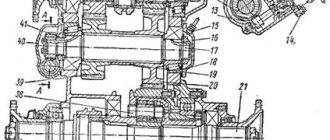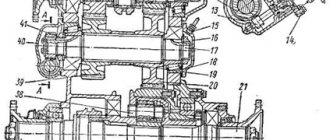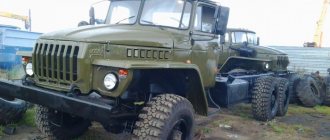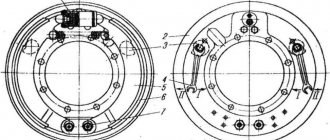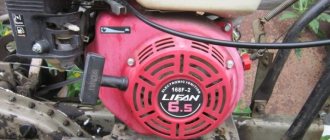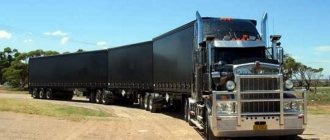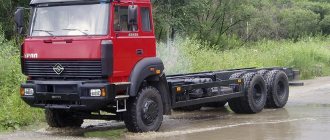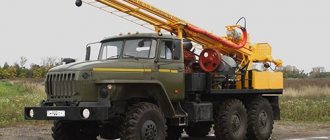The ZIL-137 road train was created back in 1963 for the transportation of long and other cargo. A road train is a tractor with a semi-trailer. This model implemented technical solutions that were innovative for its time. Subsequently, the ZIL-137 repeatedly served as a field for testing various improvements and innovations. Today, this model is actively used for transporting long items and as a military truck, which has proven itself in difficult operating conditions and under heavy loads. The photo of the ZIL 137 clearly shows that this heavy three-axle tractor can be used to tow trailers and semi-trailers with various loads.
GAZ-63D
GAZ-63D with a GAZ-745 semi-trailer
One of the first active road trains was created at the Gorky Automobile Plant in 1958. The road train consisted of a GAZ-63D all-wheel drive tractor and a GAZ-745 single-axle 4-ton semi-trailer. The GAZ-63D was originally developed as a tractor for a dump semi-trailer, and therefore was equipped with a power take-off (PTO). From it, through a system of gearboxes and cardan shafts, torque was transmitted to the drive axle of the semi-trailer. The latter received an all-metal cargo platform covered with an awning and a bridge from the GAZ-63.
GAZ-66K being tested
The first tests demonstrated the general unreliability of the mechanical torque transmission system. In addition, the standard GAZ-63D units turned out to be not suitable for working under high loads as part of an active road train. Nevertheless, work on the topic continued and three years later, the Gaza team built another active road train. This time based on the GAZ-66K truck tractor. The new GAZ-66K cabover was also equipped with a PTO, to which the mechanical drive of the active semi-trailer was connected. Thanks to a more powerful tractor, the road train performed better off-road, but problems with reliability and overall efficiency of the system were never resolved. So the GAZ developments did not receive serial implementation.
Identity crisis
By 1990, the plant planned to transfer the obsolete ZIL-130 to its Ural branch of UAMZ, but until the new model finally took its place, they decided to leave the car in production at the head plant. 1991 came and everything changed. The country was splitting, the new president set a course for a market economy, and truck production was not according to plan, but according to needs. But the country no longer had the former need for 200 thousand 6-ton trucks. All mutual settlements on prices within the country were canceled, and against this background, Yeltsin opened the borders for the import of used equipment, sharply lowering import duties. At the same time, as part of the conversion, cars from the warehouses of the USSR Ministry of Defense began to go on free sale. As a result, the production of motor vehicles in all countries of the former USSR fell sharply by 10 times.
Understanding the complexity of the situation, the management of the ZIL plant decides to create a new family of light-duty trucks with a payload of 1.5–3 tons. This was required by market relations and the emergence of small businesses in the country. At the time of 1991–1992, there were no manufacturers in the country in the 1.5–2 t segment. Czech Avia, Polish Nysa and Zuk left the market. The domestic UAZ-3303 and the Latvian RAF-33111 “Latvia” competed for the 1-ton niche. Until 1993, the Gorky Automobile Plant produced outdated GAZ-52 and GAZ-53A with 2.5 and 4 tons of cargo, respectively, and also mastered the new GAZ-3307 family with 3–4.5 tons of cargo. In a word, there was still something to fight for.
Important Decent Sampo Rosenlew combine harvesters
Three factories took up the creation of the lorry: GAZ had already devoted all its efforts to creating the GAZ-3302 GAZelle, the Bryansk Automobile Plant, together with the English company IAD, was making its model BAZ-3778. And at the Moscow plant, several groups of engineers and production workers were involved in the work.
ZIL-137
Experienced ZIL-4E137
In parallel with the Gorky Automobile Plant, active road trains were also built at ZIL. In 1956, they experimented with the ZIS-121D tractor and a single-axle active semi-trailer with a mechanical drive. In the course of further work on this topic, in 1962 the Zilov team assembled another road train based on the ZIL-157K, also with a mechanical drive.
By this time, the optimal scheme for all-wheel drive road trains began to crystallize, in the form of a three-axle tractor and a two-axle semi-trailer with a general wheel arrangement of 10x10. In addition, it turned out that the simplest and cheapest mechanical method of transmitting torque to a semi-trailer has a bunch of disadvantages. These included kinematic inconsistencies when rotating the wheels of the tractor and semi-trailer, non-optimal redistribution of traction on all wheels of the road train, as well as the overall complexity and low reliability of the system. As a result, the designers began building a fundamentally new active road train with hydraulic drive of semi-trailer wheels.
Road train diagram: 1) Oil tank 2) PTO 3) Hydraulic pump 4) Hydraulic hose 5) Hydraulic motor 6) Gearbox 7) Cardan shaft Semi-trailer axle gearbox 9) Hydraulic pump drive 10) Transfer case
The first experimental road train, ZIL-137, was assembled in 1963. It was based on a ZIL-137T tractor with a power of 150 hp. with a piston hydraulic pump with a working pressure of up to 150 kgf/cm3. The operating principle of the hydraulic transmission was quite simple. Oil under pressure from the hydraulic pump was supplied through a hose to the hydraulic motor, which drove the driving axles of the rolling stock through a reduction gearbox and cardan shafts.
In 1964, the ZIL-137 successfully passed serial tests and was accepted for small-scale production at the Bryansk Automobile Plant. Actual operation in the army has shown that it is highly reliable and maintainable. In addition, ZIL-137 was quite expensive, so it did not receive mass distribution.
Video
The model inherited from the ZIS-151 a complex transmission, supplemented by cardan shafts:
- to medium;
- intermediate;
- rear (two) and front axles.
ZIL-157 was equipped with larger wheels. This model was the first to use a centralized tire pressure control system. Thanks to this, the driver could control the tire pressure (by choice or all at once) from the workplace. A special compressor made it possible to move with holes in the wheels. In wetlands or virgin snow, the driver could lower the pressure. True, in this case the tire life was also reduced.
The technical characteristics of the ZIL-157, despite the fact that the model appeared in Soviet times, remain relevant today. The truck is used in Altai, the Far North, Central Asia and Ukraine. Moreover, the key advantage of the model is the highest cross-country ability.
The main disadvantage of the car is the lack of hydraulic power steering, but this does not significantly affect the popularity of the truck in the domestic market.
The model was produced in several modifications:
- ZIL-157 – standard version;
- ZIL-157V – classic truck tractor;
- ZIL-157K - basic version since 1961;
- ZIL-157KV - basic truck tractor since 1961;
- ZIL-157Yu – tropical modification;
- ZIL-157G – model with shielded equipment;
- ZIL-157KG - version with shielded equipment, which entered the series in 1961;
- ZIL-157E – export modification;
- ZIL-157E - a special version, equipped with two gas tanks with a total capacity of 300 liters;
- ZIL-157KD - basic version since 1978;
- ZIL-157KDV is the basic truck tractor since 1978.
Technical specifications in numbers
- Overall dimensions: length – 9400 mm; width – 2550 mm; height – 3200 mm.
- The length of the wheelbase between the first and second axles is 2400 mm.
- The length of the wheelbase between the second and third axles is also 2400 mm.
- Ground clearance – 475 mm.
- The front and rear track widths are the same – 2000 mm.
- The smallest turning radius is 12 meters.
- Wheel formula – 6 x 6.
- Number of seats - 3 in the cabin, 8-12 in the cargo-passenger compartment.
- Curb weight – 9680 kg.
- Total weight – 12034 kg.
- The width of the ditch to be overcome is 2 meters.
- The amount of climb to be overcome is 30 degrees.
- The maximum lateral roll is 15 degrees.
- The volume of fuel tanks is 2 x 170 liters.
- Tire size – 16.00-20″/ IYA-333.
Malfunctions
Later, as the car was used, various shortcomings began to appear. Most often, the problems were associated with hydraulics that were quite complex in design and capricious in terms of oil quality. Very often during operation it was possible to observe discrepancies in the operation of the wheels under load and during braking. As noted above, in the first half of the 70s, the Bryansk plant developed a similar road train with the index 137M to replace the 137th. Among the differences in this model was the mechanical type of trailer drive, which was more reliable. Then the model received a new name in BAZ-3405.
Cabin
An important distinguishing feature of the ZIL 131 military vehicle is its comfortable all-metal cabin in comparison with its predecessor ZIL 157. It immediately stands out for its interesting appearance, which is still relevant for vehicles of this class today
In addition, it is more comfortable for the driver and two passengers. The advantages also include:
- reinforced frame;
- efficient heating and ventilation systems;
- rotating window vents;
- separate seats for driver and passengers;
- adjustable driver's seat;
- high-quality ergonomics;
- compact, easy-to-read information on the dashboard, which displayed:
- voltage in the on-board network,
- fuel level,
- movement speed,
- engine oil pressure,
- temperature in the cooling system,
- the speed of the power unit.
The large steering wheel made it possible to conveniently control the all-terrain vehicle, especially in rough terrain, and the driver's position and wide windshield provided increased visibility when the truck was moving.
Spacious cabin doors, as well as reinforced opening handles, made it possible, if necessary, to leave very quickly or, conversely, to perform a quick landing, which is extremely important for an army vehicle.
Cabin ZIL 131
Advanced Development
This road train was intended for use in the armed forces of the USSR. At one time it was the most advanced development of the domestic automobile industry of those years. The tractor and trailer appeared as a result of the continuation of experiments that began in 1960 with the ZIL-157V truck tractor. After a series of modifications and upgrades, the ZIL-137 was maximally unified with the 131st model. The tractor received the index 2E131. The car could be equipped with one of two trailers. They had their own indexes:
- 3E131.
- 4E131.
Then the all-terrain vehicle received the index 137. The first experimental vehicle was built in Moscow in 1963. Next came a series of tests - the car was tested and refined many times until 1964. In the same year, the tractor performed well in a series of tests at the state level.
The mileage at that time was 18 thousand km. The vehicle was recommended for production and use in the army. The car was put into service in 1966, and then in 1970, along with ZIL; BAZ specialists participated in the assembly processes. ZIL-137 tractors came to the plant from Moscow. And at the Bryansk plant they were assembling trailers.
By the mid-70s, the plant reached volumes of up to 30 units per month. For the first time in the history of the USSR, these tractors were used to develop a culture of serial production of fairly complex and technologically advanced hydraulic systems.
Military applications
Even before the start of development, the USSR Defense Ministry highly appreciated the prospects of the ZIL-137 tractor. The technical characteristics of the model were at the highest level. The main task of the vehicle is to work as a transport for storing and delivering 2K11 air defense missiles to combat positions.
The car successfully passed these tests in 1963. Later, based on a tractor and trailer, the plant created transport vehicles for the Kub and Tochka missiles. The tractor was also operated together with the AKhB-2.5 baking unit. Parts and elements of pontoon bridges and mine trawls were also transported on road trains based on this vehicle. It was also planned to install a modernized pontoon park on them. But this idea remained unrealized.
Models with long trailers are most widespread - their index is 137B. They were used for long ammunition and missile systems. Also, various roomy vans with military equipment were often installed on trailers.
Engine
If you look at the ZIL-137 operating manual, you can find information about power units that were completely unified with the ZIL-131 V truck tractor. The latter, in turn, was created on the basis of the 131st model. All these cars in the 60s were equipped with a gasoline four-stroke carburetor V8 - ZIL-5081. Its volume was 6 liters. The rated power, taking into account the presence of a speed limiting system, reached 150 hp. With. The engine is overhead valve, equipped with a liquid cooling system.
The engine compression ratio was 6.5. Torque – 410 Nm. Fuel consumption with this unit for a truck tractor is considerable. Appetites were provided by two fuel tanks of 170 liters each.
Reasons for the appearance and purpose of a military truck
The key task of creating the ZIL 131 was to replace its predecessor, the ZIL 157, in army transport. By the mid-60s, this outdated model was no longer suitable for the army, neither in terms of its carrying capacity, nor in terms of cross-country ability, as well as in speed and comfort.
The main purpose of the new car was:
- transportation of personnel with light weapons;
- transportation of various cargoes and special equipment;
- towing trailers, semi-trailers, weapon systems on roads with various surfaces, in off-road conditions and rough terrain.
The most common version of the ZIL 131, according to Wikipedia, was a tilt version of the truck with a universal wooden platform, allowing it to transport people and cargo both separately and simultaneously, as well as to tow artillery weapons or other trailers.
The next most popular vehicle was the ZIL 131V truck tractor for transporting semi-trailers and weapon systems for various purposes. Also, large quantities of specialized fuel and oil dispensers, command and communication vehicles, mobile workshops and laboratories were manufactured using the chassis of this truck.
In the civilian sphere, the truck is most widespread in the mining industries, in the northern and remote regions of our country, and in the timber industry. In addition, a large number of specialized fire fighting vehicles (tanks, extendable ladders, command vehicles, hydraulic lifts, manipulators, etc.) have been developed on an all-wheel drive basis. The most unusual version of the vehicle in the civilian version was an all-wheel drive dump truck for agricultural purposes, which could work in tandem with a trailer in fields with heavy soils.
Cars under the designation ZIL 131S and AS were intended for operation in the Far North at temperatures down to -60 degrees. This northern version of the car had an additional autonomous heater, special rubber components, double windows and additional thermal insulation of the cabin, and thermal protection for the battery. For hot tropical climates, a model was produced under the designation 131 X.
